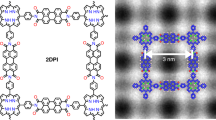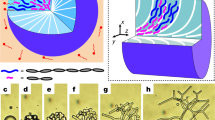Abstract
Technological applications of liquid crystals have generally relied on control of molecular orientation at a surface or an interface1,2. Such control has been achieved through topography, chemistry and the adsorption of monolayers or surfactants2,3. The role of the substrate or interface has been to impart order over visible length scales and to confine the liquid crystal in a device. Here, we report results from a computational study of a liquid-crystal-based system in which the opposite is true: the liquid crystal is used to impart order on the interfacial arrangement of a surfactant. Recent experiments on macroscopic interfaces have hinted that an interfacial coupling between bulk liquid crystal and surfactant can lead to a two-dimensional phase separation of the surfactant at the interface4, but have not had the resolution to measure the structure of the resulting phases. To enhance that coupling, we consider the limit of nanodroplets, the interfaces of which are decorated with surfactant molecules that promote local perpendicular orientation of mesogens within the droplet. In the absence of surfactant, mesogens at the interface are all parallel to that interface. As the droplet is cooled, the mesogens undergo a transition from a disordered (isotropic) to an ordered (nematic or smectic) liquid-crystal phase. As this happens, mesogens within the droplet cause a transition of the surfactant at the interface, which forms new ordered nanophases with morphologies dependent on surfactant concentration. Such nanophases are reminiscent of those encountered in block copolymers5, and include circular, striped and worm-like patterns.
This is a preview of subscription content, access via your institution
Access options
Subscribe to this journal
Receive 51 print issues and online access
$199.00 per year
only $3.90 per issue
Buy this article
- Purchase on Springer Link
- Instant access to full article PDF
Prices may be subject to local taxes which are calculated during checkout




Similar content being viewed by others
References
Collins, P. J. & Hird, M. Introduction to Liquid Crystals Chemistry and Physics (Taylor and Francis, 2004)
Jerome, B. Surface effects and anchoring in liquid crystals. Rep. Prog. Phys. 54, 391–451 (1991)
Shah, R. & Abbott, N. L. Principles for measurement of chemical exposure based on recognition-driven anchoring transitions in liquid crystals. Science 293, 1296–1299 (2001)
Gupta, J., Meli, M., Teren, S. & Abbott, N. L. Elastic energy-driven phase separation of phospholipid monolayers at the nematic liquid-crystal-aqueous interface. Phys. Rev. Lett. 100, 048301 (2008)
Bates, F. & Fredrickson, G. Block copolymers—designer soft materials. Phys. Today 52, 32–38 (1999)
de Gennes, P. G. & Prost, J. The Physics of Liquid Crystals (Oxford University Press, 1995)
Barón, M. Definitions of basic terms relating to low-molar-mass and polymer liquid crystals. Pure Appl. Chem. 73, 845–895 (2001)
Price, A. & Schwartz, D. DNA hybridization-induced reorientation of liquid crystal anchoring at the nematic liquid crystal/aqueous interface. J. Am. Chem. Soc. 130, 8188–8194 (2008)
Park, J. & Abbott, N. L. Ordering transitions in thermotropic liquid crystals induced by the interfacial assembly and enzymatic processing of oligopeptide amphiphiles. Adv. Mater. 20, 1185–1190 (2008)
Sivakumar, S., Wark, K., Gupta, J., Abbott, N. L. & Caruso, F. Liquid crystal emulsions as the basis of biological sensors for the optical detection of bacteria and viruses. Adv. Funct. Mater. 19, 2260–2265 (2009)
Price, A. & Schwartz, D. Fatty-acid monolayers at the nematic/water interface: phases and liquid-crystal alignment. J. Phys. Chem. B 111, 1007–1015 (2007)
Fernández-Nieves, A. et al. Novel defect structures in nematic liquid crystal shells. Phys. Rev. Lett. 99, 157801 (2007)
Fernández-Nieves, A., Link, D., Marquez, M. & Weitz, D. Topological changes in bipolar nematic droplets under flow. Phys. Rev. Lett. 98, 087801 (2007)
Gupta, J., Sivakumar, S., Caruso, F. & Abbott, N. Size-dependent ordering of liquid crystals observed in polymeric capsules with micrometer and smaller diameter. Angew. Chem. 48, 1652–1655 (2009)
Yamamoto, J. & Tanaka, H. Transparent nematic phase in a liquid-crystal-based emulsion. Nature 409, 321–325 (2001)
Fernández-Nieves, A., Link, D. R. & Weitz, D. A. Polarization dependent Bragg diffraction and electro-optic switching of three-dimensional assemblies of nematic liquid crystal droplets. Appl. Phys. Lett. 88, 121911 (2006)
Humar, M., Ravnik, M., Pajk, S. & Musevic, I. Electrically tunable liquid crystal optical microresonators. Nature Photon. 3, 595–600 (2009)
Yokohama, H. Tunable whispers. Nature Photon. 3, 560–561 (2009)
Lin, I. et al. Endotoxin-induced structural transformations in liquid crystalline droplets. Science 332, 1297–1300 (2011)
Luckhurst, G. R. & Simmonds, P. S. J. Computer simulation studies of anisotropic systems. XII. Parameterization of the Gay-Berne potential for model mesogens. Mol. Phys. 80, 233–252 (1993)
Jackson, A., Myerson, J. & Stellacci, F. Spontaneous assembly of subnanometre-ordered domains in the ligand shell of monolayer-protected nanoparticles. Nature Mater. 3, 330–336 (2004)
Singh, C. et al. Entropymediated patterning of surfactant-coated nanoparticles and surfaces. Phys. Rev. Lett. 99, 226106 (2007)
Kotov, N. & Stellacci, F. Frontiers in nanoparticle research: toward greater complexity of structure and function of nanomaterials. Adv. Mater. 20, 4221–4222 (2008)
Juffer, A. H. & Berendsen, H. J. C. Dynamical surface boundary conditions: a simple boundary model for molecular dynamics simulations. Mol. Phys. 79, 623–644 (1993)
Frenkel, D. & Smith, B. Understanding Molecular Simulations—From Algorithms to Applications (Academic Press, 1996)
Allen, M. & Tildesley, D. Computer Simulation of Liquids (Oxford Science Publications, 1987)
Gay, J. G. & Berne, B. J. Modification of the overlap potential to mimic a linear site-site potentials. J. Chem. Phys. 74, 3316–3319 (1981)
Ilnytskyi, M. & Wilson, M. R. A domain decomposition molecular dynamics program for the simulation of flexible molecules of spherically-symmetrical and nonspherical sites. II. Extension to NVT and NPT ensembles. Comput. Phys. Commun. 148, 43–58 (2002)
Acknowledgements
The continuum analysis of liquid crystal interfaces and the development of the corresponding theory were supported by the Department of Energy, Basic Energy Sciences, Biomaterials Program (DE-SC0004025). The calculations of surfactant organization at nanodroplet interfaces were supported by the National Science Foundation (DMR-1121288). The calculations reported here were performed on computational facilities supported by the National Science Foundation (DMR-1121288).
Author information
Authors and Affiliations
Contributions
J.A.M.-R. performed the molecular dynamics and Monte Carlo simulations presented in this work. E.J.S. provided critical analysis of droplet structures. N.L.A. was involved in study design. J.P.H.-O. performed the continuum calculations presented in this work. J.J.d.P. designed the study, analysed data, and wrote the paper. All authors discussed the results and commented on the manuscript.
Corresponding author
Ethics declarations
Competing interests
The authors declare no competing financial interests.
Supplementary information
Supplementary Information
This file contains Supplementary Text and Data 1- 4, Supplementary References and Supplementary figures 1-7. (PDF 4772 kb)
Rights and permissions
About this article
Cite this article
Moreno-Razo, J., Sambriski, E., Abbott, N. et al. Liquid-crystal-mediated self-assembly at nanodroplet interfaces. Nature 485, 86–89 (2012). https://doi.org/10.1038/nature11084
Received:
Accepted:
Published:
Issue Date:
DOI: https://doi.org/10.1038/nature11084
This article is cited by
-
Smartphone-based platforms implementing microfluidic detection with image-based artificial intelligence
Nature Communications (2023)
-
Non-equilibrium steady structures of confined liquid crystals driven by a dynamic boundary
Science China Physics, Mechanics & Astronomy (2019)
-
On the Defect Structure of Biaxial Nematic Droplets
Scientific Reports (2018)
-
Optical imaging of cholylglycine by using liquid crystal droplet patterns on solid surfaces
Journal of Materials Science (2016)
-
Superior electro-optic response in multiferroic bismuth ferrite nanoparticle doped nematic liquid crystal device
Scientific Reports (2015)
Comments
By submitting a comment you agree to abide by our Terms and Community Guidelines. If you find something abusive or that does not comply with our terms or guidelines please flag it as inappropriate.



